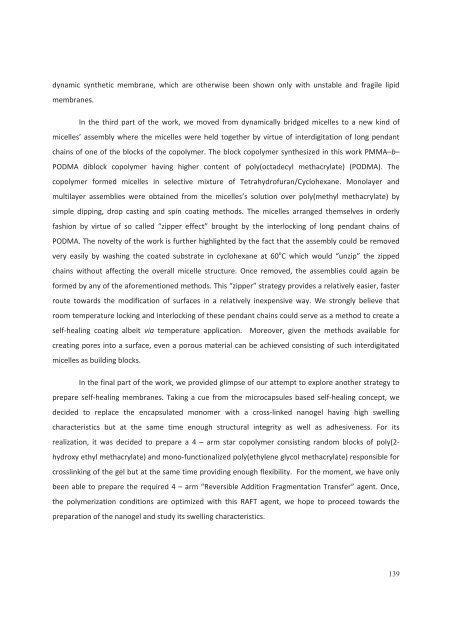4(%3)3 - Ecole nationale supérieure de chimie de Montpellier
4(%3)3 - Ecole nationale supérieure de chimie de Montpellier
4(%3)3 - Ecole nationale supérieure de chimie de Montpellier
Create successful ePaper yourself
Turn your PDF publications into a flip-book with our unique Google optimized e-Paper software.
dynamic synthetic membrane, which are otherwise been shown only with unstable and fragile lipidmembranes.In the third part of the work, we moved from dynamically bridged micelles to a new kind ofmicelles’ assembly where the micelles were held together by virtue of interdigitation of long pendantchains of one of the blocks of the copolymer. The block copolymer synthesized in this work PMMA–b–PODMA diblock copolymer having higher content of poly(octa<strong>de</strong>cyl methacrylate) (PODMA). Thecopolymer formed micelles in selective mixture of Tetrahydrofuran/Cyclohexane. Monolayer andmultilayer assemblies were obtained from the micelles’s solution over poly(methyl methacrylate) bysimple dipping, drop casting and spin coating methods. The micelles arranged themselves in or<strong>de</strong>rlyfashion by virtue of so called “zipper effect” brought by the interlocking of long pendant chains ofPODMA. The novelty of the work is further highlighted by the fact that the assembly could be removedvery easily by washing the coated substrate in cyclohexane at 60 o C which would “unzip” the zippedchains without affecting the overall micelle structure. Once removed, the assemblies could again beformed by any of the aforementioned methods. This “zipper” strategy provi<strong>de</strong>s a relatively easier, fasterroute towards the modification of surfaces in a relatively inexpensive way. We strongly believe thatroom temperature locking and interlocking of these pendant chains could serve as a method to create aself-healing coating albeit via temperature application. Moreover, given the methods available forcreating pores into a surface, even a porous material can be achieved consisting of such interdigitatedmicelles as building blocks.In the final part of the work, we provi<strong>de</strong>d glimpse of our attempt to explore another strategy toprepare self-healing membranes. Taking a cue from the microcapsules based self-healing concept, we<strong>de</strong>ci<strong>de</strong>d to replace the encapsulated monomer with a cross-linked nanogel having high swellingcharacteristics but at the same time enough structural integrity as well as adhesiveness. For itsrealization, it was <strong>de</strong>ci<strong>de</strong>d to prepare a 4 – arm star copolymer consisting random blocks of poly(2-hydroxy ethyl methacrylate) and mono-functionalized poly(ethylene glycol methacrylate) responsible forcrosslinking of the gel but at the same time providing enough flexibility. For the moment, we have onlybeen able to prepare the required 4 – arm “Reversible Addition Fragmentation Transfer” agent. Once,the polymerization conditions are optimized with this RAFT agent, we hope to proceed towards thepreparation of the nanogel and study its swelling characteristics.139











